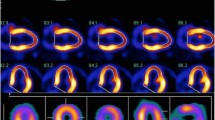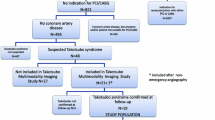Abstract
We compared the usefulness of18F-fluorodeoxyglucose (18FDG)-PET with glucose loading and thallium-201 (201Tl) reinjection imaging for determining the viability of the myocardium in 21 patients with an old anterior myocardial infarction. We obtained transaxial views during201T1 reinjection imaging performed 10 minutes after post-exercise injection of 37 MBq201Tl. PET imaging with 75 g oral glucose loading was performed 60 min after injection of 148 MBq of I8FDG. Wall motion was evaluated by echocardiography. Excellent18FDG-PET images were obtained in 19 of 21 subjects in whom plasma glucose levels were below 251 mg/d/. The results of201Tl reinjection imaging and18FDG-PET imaging were in agreement in 20 of the 21 subjects. Echocardiography demonstrated hypokinesis or akinesis in segments identified as abnormal in imaging studies. Our results showed that201Tl reinjection imaging identified the viable and necrotic myocardium similarly to metabolic imaging obtained by18FDG-PET with glucose loading.
Similar content being viewed by others
References
Braunwald E, Kloner RA. The stunned myocardium: Prolonged, postischemic ventricular dysfunction.Circulation 66: 1146–1149, 1982.
Braunwald E, Rutherford JD. Reversible ischemic left ventricular dysfunction: Evidence for the “Hibernating myocardium.”J Am Coll Cardiol 8: 1467–1470, 1986.
Dilsizian V, Rocco TP, Freedman NMT, Leon MB, Bonow RO. Enhanced detection of ischemic but viable myocardium by the reinjection of thallium after stress-redistribution imaging.N Engl J Med 323: 141–146, 1990.
Gibson RS, Watson DD, Taylor GJ, Crosby IK, Wellons HL, Holt ND, et al. Prospective assessment of regional myocardial perfusion before and after coronary revascularization surgery by quantitative thallium-201 scintigraphy.J Am Coll Cardiol 1: 804–815, 1983.
Liu P, Kiess MC, Okada RD, Block PC, Strauss HW, Pohost GM, et al. The persistent defect on exercise thallium imaging and its fate after myocardial revascularization: does it represent scar or ischemia?Am Heart J 110: 996–1001, 1985.
Rocco TP, Dilsizian V, Mckusick A, Fischman AJ, Boucher CA, Strauss HW. Comparison of thallium redistribution with rest “reinjection” imaging for the detection of viable myocardium.Am J Cardiol 66: 158–163, 1990.
Ohtani H, Tamaki N, Yonekura Y, Mohiuddin IH, Hirata K, Ban T, et al. Value of thallium-201 reinjection after delayed SPECT imaging for predicting reversible ischemia after coronary bypass grafting.Am J Cardiol 66: 394–399, 1990.
Bonow RO, Berman DS, Gibbons RJ, Johnson LL, Rumgerger JA, Schwaiger M, et al. Cardiac positron emission tomography.Circulation 84: 447–454, 1991.
Tamaki N, Yonekura Y, Yamashita K, Senda M, Saji H, Hashimoto T, et al. Relation of left ventricular perfusion and wall motion with metabolic activity in persistant defects on thallium-201 tomography in healed myocardium infarction.Am J Cardiol 62: 202–208, 1988.
Tamaki N, Yonekura Y, Yamashita K, Mukai T, Magata Y, Hashimoto T, et al. SPECT thallium-201 tomography and positron tomograpy using N-13 ammonia and F-18 fluorodeoxyglucose in coronary artery disease.Am J Cardiac Imaging 3: 3–9, 1989.
Gropler RJ, Sigel BA, Lee KJ, Moerlein SM, Perry DJ, Bergmann SR, et al. Nonuniformity in myocardial accumulation of fluorine-18-fluorodeoxyglucose in normal fasted humans.J Nucl Med 31: 1749–1756, 1990.
Schwaiger M, Hicks R. The clinical role of metabolic imaging of the heart by positron emission tomography.J Nucl Med 32: 565–578, 1991.
Judkins MP. Selective coronary angiography—a percutaneous transfemoral technic.Radiol 89: 815–824, 1967
Melvin P, Judkins MP. Percutaneous transfemoral coronary arteriography.Radiol Clin North Am 6: 467–492, 1968.
Dilsizian V, Bonow RD. Current diagnostic techniques of assessing myocardial viability in patients with hibernating and stunned myocardium.Circulation 87: 1–20, 1993.
Budinger TF, Pohost GM. Thallium ‘redistribution’: An explanation.J Nucl Med 27: 996, 1986 (abstract).
Camici P, Ferranini E, Opie LH. Myocardial metabolism in ischemic heart disease: basic principles and application to imagingby positron emission tomography.Prog Cardiovasc Dis 32: 217–238, 1989.
Fudo T, Kambara H, Hashimoto T, Hayashi M, Nohara R, Tamaki N, et al. F-18 deoxyglucose and stress N-13 ammonia positron emission tomography in anterior wall healed myocardial infarction.Am J Cardiol 60: 1191–1197, 1988.
Marshall RC, Tillisch JH, Phelps ME, Huang SC, Carson R, Henze E, et al. Identification and differentiation of myocardial ischemia and infarction in man with positron computed tomography, F-18-labeled fluorodeoxyglucose and N-13 ammonia.Circulation 67: 766–788, 1983.
Berry JJ, Schwaiger M. Metabolic imaging with positron emission tomography.Current Opinion in Cardiology 5: 803–812, 1990.
Knuuti MJ, Nuutila P, Ruotsalainen U, Saraste M, Harkonen R, Ahonen A, et al. Euglycemic hyperinsulinemic clamp and oral glucose load in stimulating myocardial glucose utilization during positron emission tomography.J Nucl Med 33: 1255–1262, 1992.
Tamaki N, Ohtani H, Yamashita K, Magata Y, Yonekura Y, Nohara R, et al. Metabolic activity in the area of new fill-in after thallium-201 reinjection: comparison with positron emission tomography using fluorine-18-deoxyglucose.J Nucl Med 32: 673–678, 1991.
Bonow RO, Dilsizian V, Cuocolo A, Bacharach SL. Identification of viable myocardium in patients with chronic coronary artery disease and left ventricular dysfunction.Circulation 83: 26–37, 1991.
Author information
Authors and Affiliations
Rights and permissions
About this article
Cite this article
Ogiu, N., Nakai, K. & Hiramori, K. Thallium-201 reinjection images can identify the viable and necrotic myocardium similarly to metabolic imaging with glucose loading18F-fluorodeoxyglucose (18FDG)-PET. Ann Nucl Med 8, 171–176 (1994). https://doi.org/10.1007/BF03164993
Received:
Accepted:
Issue Date:
DOI: https://doi.org/10.1007/BF03164993




